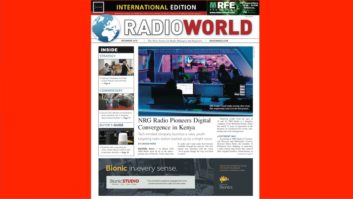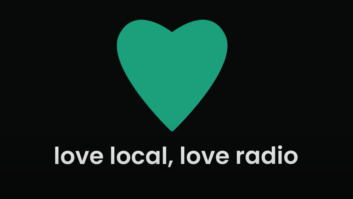BRUSSELS — In Belgium, working from home, whether to avoid traffic jams or cut on transport expenses, is rapidly gaining favor. Figures published in September 2018 revealed that about one-third of the country’s active population is adopting telecommuting.

The 14-station strong Flemish station Stadsradio Vlaanderen premiered the new formula of remote radio production and presentation on Sept. 3. That was followed by Radio Contact, with 41 frequencies in the French-speaking part of Belgium, a few days later. The common element in both “home-production” on-air studios is the implementation of a Lawo crystalCLEAR virtual mixing console.
FROM HOME
“The main reason for ‘teleworking’ is that both employers and employees want to avoid transport expenses and time loss,” explained Joe Wells, Stadsradio Vlaanderen morning drive presenter. “Our main on-air studios are located in Mechelen, Leuven and Ghent (the nearest, Mechelen being 35 kilometers/22 miles away) but traveling there may take several hours.”
Wells added that during weekdays, the station’s morning show, and daily programs like the “The best of the Top 40,” hosted by Serge Hadermann, the “Lunch Break,” presented by Guy Van Antwerpen and DJ Marcel’s “Flanders is Flashing,” are produced in the respective presenters’ home studios.
With a beautiful view on the Antwerp skyline and plenty of daylight, Joe Wells has a fully-fledged broadcast studio to present his daily morning show (“Jojo in the morning”).

“The core of the studio is a Lawo crystalCLEAR console with VisTool MK2 software serving two touchscreen displays adding up to a total of 24 channels — a virtual mixing desk without mechanical faders,” he said. “The console is equipped with full processing for radio with limiters, expanders, de-esser, a compressor and, of course, an equalizer. As far as I know, this was the first ever Lawo crystalCLEAR in the country, and worth every euro of the investment.”
The studio furthermore includes three Neumann TLM 103 mics, four Genelec 8340A studio monitors and three telephone hybrids — two Sonifex DHY-04HD voice hybrids, one EELA-Audio Digital Hybrid EA915X.
Wells is using the station’s standard playout system, Radiohost Broadcast 5.404. “As for signal transmission to the main on-air studio, I have installed the EdCast v3 320 kbps (44.1 kHz) streaming software as well as the DEVA DB9000-TX AoIP encoder,” said Wells.
FLEXIBILITY
With its “16–20” evening drive program, leading French-language commercial broadcaster, Radio Contact premiered radio-teleworking for the first time on Sept. 7. David Antoine hosts the four-hour long live show.

“Teleworking is encouraged as a more efficient way to do business, and by launching telework on Radio Contact, we want to adapt the principle,” said Michel Pachen, director of radio production for Radio Contact, BelRTL and Mint.
“And I guess that in the future, people will be doing their programs from anywhere,” he added, referring to a scene in the 1997 Luc Besson movie “The Fifth Element” where a radio DJ runs through the corridors of a venue holding what could be a microphone.
Antoine presents his “16–20” show live and direct from his living room on Fridays. And like his radio colleagues north of the language border, he’s using a Lawo crystalCLEAR virtual mixing console.
“The big advantage of this console, is that the presenter needn’t worry about microphone levels,” continued Pachen. “Thanks to the incorporated AutoMix function, microphones can be used without technical assistance, while manual control remains possible via the console’s touchscreen display.”
Pachen echoed the advantage of microphone processing at this stage where it is controlled by the console’s digital signal processing software. “This is quite handy and the system works great — very accurate and without any latency.” In the main Radio Contact facility, the fully mixed audio signal is processed to fit the station’s sound image.
Antoine and his co-host Lucie Rochelet use BeyerDynamic DT 790 headsets. “You cannot compare a living room with a broadcast studio in terms of acoustics,” added Pachen. “By using headsets, we limit problems like reverberation.”
The setup is completed with Netia Quick-Player software for manual starting of jingles during the broadcast. A Prodys Quantum IP codec routes the program signal to Radio Contact’s on-air studio where a Netia Radio Assist 8.0.8.0810 playout system takes on the management of music content and commercials.
[Read: Joe Launches Two Digital Channels]
With two mobile radio studios and a K-SAT vehicle with room for four presenters, Radio Contact, Bel RTL and Mint have the equipment for handling remote broadcasts.
Pachen looks forward. “But this is different, and I strongly believe this is the future — David’s apartment is a laboratory. The next step will be ‘teleworking project 2.0’ where we relocate a complete studio. In addition, tomorrow’s presenters will move around with their gear in a backpack. We are already implementing this in Bel RTL’s ‘Le Morning’ daily show where a presenter broadcasts from his car using a Prodys Quantum Lite handheld codec. “










